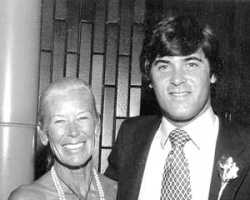
To many people, Joan Stegman was Mrs. Seal Beach.
Whether she was arguing against changing zoning laws at city hall meetings or giving a lecture for the Seal Beach Historical Society, there was always something fabulous about the longtime Seal Beach resident and advocate of the city’s people and its history.
Even those who disagreed with her at times noticed her sense of class and style.
Stegman died on Sept. 23. She was 90 years old.
As a young woman, Stegman possessed the looks of a cover-girl model. However, she seemed to prefer the simple life she found in her city by the sea.
“She was very unassuming,” said her son Gene.
She kept a low profile for the most part and then would come out to state her opinions on various issues in Seal Beach as they arose.
Born in Bakersfield in 1920, Stegman’s grandparents built a beach cottage on 12th Street in 1906 and she started visiting the beach town in the late 1920s. Her grandparents also owned the Willard Hotel, where U.S. President William Howard Taft is said to have stayed during a visit to Seal Beach when it was still known as Bay City.
She paid her own way through school and graduated from the University of Southern California. After that she went on to become a buyer for The Broadway.
Stegman married her first husband Wilson Leahy II and together they had her first son, the late Wilson (Rocky) Lehey III, in Los Angeles, on July 29, 1946. His father died shortly after his birth, and in 1949 his mother married Gene Stegman, who subsequently adopted Rocky. Rocky was raised in the Griffith Park area of northwest Los Angeles.
Gene Stegman was in the jewelry business and when he retired the family moved down to Seal Beach. Thus began Joan Stegman’s deep love affair with the city.
In addition to living a quiet life by the beach where she had frolicked as a youth, Stegman also found herself drawn to various causes in and around the area.
The historical society was one of her main interests and she was a key proponent of the Red Car Museum, which is housed in an old electric train car next to the city’s Mary Wilson Library.
She was influential in bringing the Red Car to the city and in its evolution into the museum as it stands today.
Another of Stegman’s causes was the Bolsa Chica wetlands and trying to preserve them in their natural form. She was also a vocal presence in the effort to save the greenbelt that runs through the greater part of Seal Beach’s Old Town neighborhood. She also donated money to the local library.
Stegman and her husband bought land in their adopted home and built apartment buildings on 11th and 13th Streets in the city’s Old Town. They lived in a unit of the apartments they built.
“She loved Seal Beach and the town loved her,” her son Gene said. “She was a major advocate for the environment and for keeping Seal Beach an underdeveloped beach town. Anytime there were any zoning law changes she was the first one to voice her disapproval.”
In her later years, Stegman was also a proponent of the work of Trees for Seal Beach’s efforts to plant more grass and trees around the city.
“I remember her selfless nature,” her son Gene said. “She was always willing to give her time and do everything she could for whomever needed her help. Everyone who met her came away impressed with her magnanimous personality and knew they had met a very special person.
Joan Stegman is survived by: her son Gene and grandson Gene. Both live in Seal Beach. Daughter Cameron Smith, granddaughter Megan and grandson Andrew of Palos Verdes and grandsons Wilson, Zach and Evan of Tulsa.
“She will be missed not only by her family, but by the many friends she made here in town,” her son Gene said.











